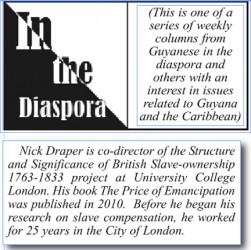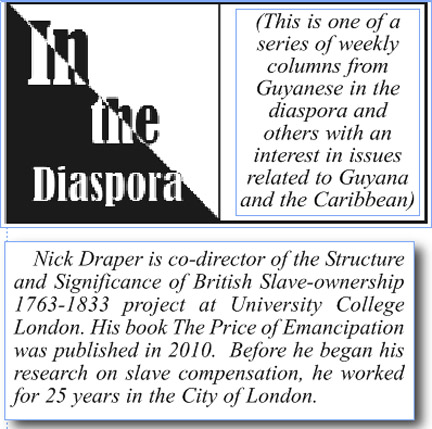By Nick Draper
Thousands of absentee slave-owners in Britain, as well as in the Caribbean, received compensation for their ‘property’ in enslaved people when slavery was abolished between 1834 and 1838. The British state paid £20 million to the colonial slave-owners, a sum equivalent to 40% of total annual government expenditure in the 1830s. The compensation would be worth some £16 billion in today’s money. The enslaved people themselves received nothing.
A team at University College London has now made available a database that shows all the recipients of this compensation, accessible at www.ucl.ac.uk/lbs. The database, which is free to access, can be searched by name of slave-owner, by place of residence in Britain if they were absentees, and by the name of the estate or plantation on which the enslaved people lived and worked before Emancipation. The information has been built up over a period of eight years, drawing originally on a single remarkable archive of material, the records of the Slave Compensation Commissioners, which are in the British National Archives at Kew, outside London.
For the territories that now make up Guyana, the database contains over 2500 separate awards made to some 3500 individual slave-owners and mortgagees. Most of these slave-owners lived in Guyana, but many of these Guyanese residents owned relatively few enslaved people. It was the 350 absentee owners living in Britain (and a handful living in Holland) who owned 70 per cent of all the enslaved men and women in Guyana.
The data show that across the whole of the Caribbean, the biggest single awards by far were concentrated in the territories that today make up Guyana. All of the top 12 awards paid worldwide to slave-owners, and a staggering 96 of the top 100 awards, were paid to slave-owners for enslaved people in Demerara, Berbice and Essequibo, together then known as British Guiana. The largest single award in the records was paid to the British MP James Blair, for 1598 people on his Blairmont estate. Other recipients among the top 12 awards were John Beckles Hyndman (the father of the British Marxist H.M. Hyndman), the Glasgow merchant James Douglas (members of whose family were later instrumental in the settlement of British Columbia) and the Liverpool railway pioneer John Moss. John Stewart, the natural son of a slave-owner of the same name and a woman called Mary Duncan, and almost certainly the first person of colour to be elected to the British House of Commons, received almost £22,500 for the enslaved people on the Annandale plantation, the scene as early as 1835 of experimentation by John Stewart, the son, with indentured labour (Stewart’s father was relatively unusual in owning enslaved people and estates in different colonies: in general slave-owners, whether British absentees or resident, owned enslaved people in only one colony). The compensation for the 331 enslaved people on Rose Hall, the estate at the heart of the 1913 uprising about which Gaiutra Bahadur wrote in this column on 11th March, was paid primarily to the London merchant firm of Barkly Davidson, who held a mortgage over the estate and the people working on it and who counterclaimed against the original claim of the Alves family.
Altogether, the awards for British Guiana represented over one quarter of the total compensation paid for the Caribbean, although only one in eight of the enslaved people in the Caribbean lived in the colony. This discrepancy arose because enslaved people in British Guiana were disproportionately valuable in the last years of slavery: on average they had been bought and sold for £120 each versus £50 on average in Jamaica. Owners in British Guiana received about 40% of this value in cash compensation (so £50 in the case of British Guiana, £20 for Jamaica); in addition, as is widely known, the formerly enslaved people were bound to a further period of 4-6 years ‘apprenticeship’.

A number of such British merchants (including John Gladstone) were also centrally involved in the movement of indentured labour into British Guiana after the end of slavery. In the 1830s, the Booker Brothers, whose firm later came to dominate Guyanese sugar, were still basically managers of other people’s estates and enslaved people: the brothers were relatively small-scale recipients of compensation, and began to build their ownership in the period of dislocation following Emancipation. However, two of the other 19th century predecessor firms of the modern Booker Brothers – John Campbell sen. and Hall, M’Garel – were large-scale slave-owners and mortgagees and are among the top 10 British merchants receiving compensation who made the transition to the new post-Emancipation world.
Altogether, the absentee slave-owners in the database played a significant role in the formation of modern Britain, and among these slave-owners, those holding enslaved people and estates in Guyana were noticeably prominent. The database traces legacies of slave-owners in British politics, business, the built environment, culture, philanthropy, and intellectual traditions (especially notions of ‘race’). Slavery was not the only force that shaped Britain, but it was an important one, and the database provides substantial evidence of the debt of Britain to slavery. At the same time, of course, the legacies of slavery and of the movement of people as indentured labourers are even more immediate in Guyana and in the former slave-societies of the Caribbean as a whole.
Together with Walter Rodney’s work in republishing late 19th century material on the Guyanese estates, the database provides an opportunity to track estates in Guyana over half a century. In a second phase of the project, we are now working on the history of the estates in the Caribbean before Emancipation. In the case of Guyana, we will go back to the beginning of British rule, and further back on those estates that in the Dutch colonial era were already owned by Britons. At the same time, we will seek to incorporate to the extent possible the histories of the enslaved people with the ownership histories of the estates on which they lived and worked. We have in our work privileged the recovery of the histories, often hidden, of the absentee slave-owners in Britain, almost all of them white and almost all of them members of British elites. Such men and women – and women slave-owners are noticeable for their presence, both among absentees and residents in the Caribbean – have almost always left traces in the archives, in official documents, in family papers that have been preserved, in civil and religious records. There are few slave-owners in Britain about whom we have been able to discover nothing. But the histories of many millions of enslaved and indentured people, by contrast, are truly lost, as many readers of African or south Asian heritage who have tried to trace their own families know. We therefore believe we have an obligation to record what we find on the enslaved populations as we find it, fragmented and partial though it will be, and to organise it by estate to give future users researching the history of enslaved people a better shot of connecting people and place.
But that work lies ahead of us. For now, the database of slave-owners is there and accessible.
We are eager to receive corrections and additions to the existing database (and in due course to the new one once developed): we know for example that there are transcription errors in the names of some estates and individuals, especially those of Dutch origin. Details of how to do this can be found on the website: www.ucl.ac.uk/lbs. You can also contact us at: lbs@ucl.ac.uk





